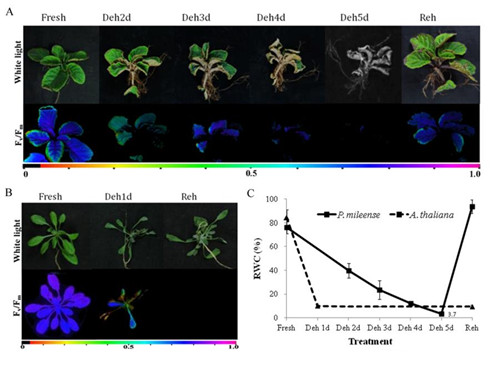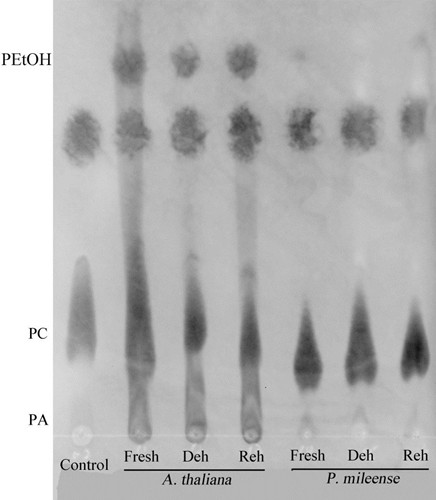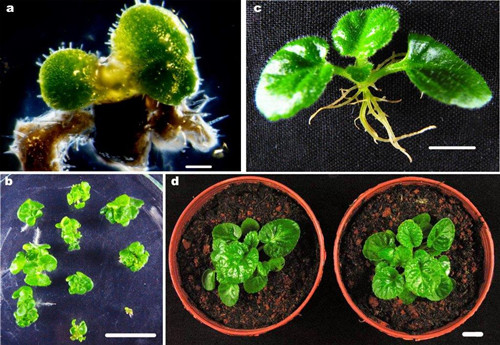Paraisometrum mileense W. T. Wang is the only species in the monotypic genus Paraisometrum W. T. Wang of family Gesneriaceae. It had been thought to be extinct for one hundred years, but was rediscovered by botanists from the Chinese Academy of Sciences. It has been given the plant species with extremely small populations because of its small remaining populations, few plant individuals, and restricted habitat. The biology characters and germplasm conservation of P. mileense is thus urgent to be researched. LI Weiqi’s group, from Kunming Institute of Botany, has made some researches on resurrection mechanisms and cryopreservation of P. mileense for recent years.
Resurrection plants have the capacity to survive from almost complete water loss. They usually endure the membrane destruction during desiccation and recovery from this destruction after rewatering. Thereby they could revive after desiccation below 10% relative water content. Research on the mechanisms by which resurrection plants tolerate extreme desiccation could help to improve or maintain crop production during drought. Under the guidance of Prof. LI Weiqi, Dr. LI Aihua and WANG Dandan from Kunming Institute of Botany found that P. mileense was a resurrection plant. They profiled the changes in the lipid molecular species during dehydration and rehydration in P. mileense. The results show that this species apply a totally different resurrection mechanism response to desiccation-without damage and repair of membrane. It uses tolerance to resist desiccation. The mechanism of its tolerance involves maintenance of the composition of the plasma membrane under severe dehydration, then suddenly disintegrate when the level of dehydration reaches a degree that the plants cannot resist. An intensive research reveals that the degradation of P. mileense is different from other resurrection plants. None increase in phosphatidic acid (PA) mediated by phospholipase D (PLD), instead of increase in diacylglycerol, a big spender degraded product, happened. Given that a limit in the size of PA pools can block lipid degradation, the absence of PLD activity should inhibit lipid degradation during desiccation in P. mileense. It is therefore proposed that P. mileense is deficient in PLD-mediated PA formation. This limits its lipid degradation through PA pools and ensures the maintenance of membrane integrity following desiccation. LI Weiqi’s group thus propose P. mileense has capacity to maintain the composition of its plasma membranes in order to tolerate severe dehydration.This group thus presents a novel model of tolerance in resurrection plants in which repair does not occur during rewatering.
Cryopreservation, the storage of biological material at an ultra-low temperature (–196 °C), is a method for the long-term preservation of plant germplasm. Dr. LIN Liang, one researcher in LI Weiqi’s group has made progress on crypreservation of P. mileense. An efficient cryopreservation procedure was established for adventitious shoot tips (ASTs) of P. mileense by droplet vitrification. The effects of sucrose concentration of preculture solution, duration of sucrose preculture, duration of plant vitrification solution 2 (PVS2) treatment, and cold acclimation on regeneration of cryopreserved ASTs were assessed. With the optimised parameters, the level of shoot regeneration from cryopreserved ASTs reached 86%. This method with minor modification was also applied to six gesneriad species which are endemic to China.
The stories were published in PLoS ONE (http://www.plosone.org/article/info%3Adoi%2F10.1371%2Fjournal.pone.0103430)and Cryoletters(http://chinesesites.library.ingentaconnect.com/content/cryo/cryo/2014/00000035/00000001/art00004). These work were supported by National Natural Science Foundation of China and 100 Talents Programme of The Chinese Academy of Sciences.

Figure 1 Dehydrated (Deh) and rehydrated (Reh) seedlings of a. P. mileense and b. A. thaliana. White coloration (upper picture) or low Fv/Fm values for variable fluorescence (lower picture). The color bar at the bottom indicates Fv/Fm values. c. Relative water content (RWC) values of P. mileense and A. thaliana following exposure to different periods of dehydration and rehydration.

Figure 2 Transphosphatidylation activities of A. thaliana and P. mileense. Reaction products were separated by thin-layer chromatography and monitored by UV colorimetric analysis.

Figure 3 Regeneration of adventitious shoot tips (ASTs) of P. mileense following cryopreservation. (a) Growth of cryopreserved ASTs on recovery medium. The photography was taken 3 weeks after rewarming (bar = 1 mm). (b) Cryopreserved ASTs formed clusters of shoots on recovery medium. The photography was taken 8 weeks after rewarming (bar = 1 cm). (c) Regenerated shoot formed a root system after 4 weeks of culture on rooting medium. The photography was taken 12 weeks after rewarming (bar = 1 cm). (d) Tissue-cultured plantlets 12 weeks after transfer to soil (left) and plantlets developed from cryopreserved ASTs 12 weeks after tranfer to soil. The photography was taken 24 weeks after rewarming (right) (bar = 1 cm).




